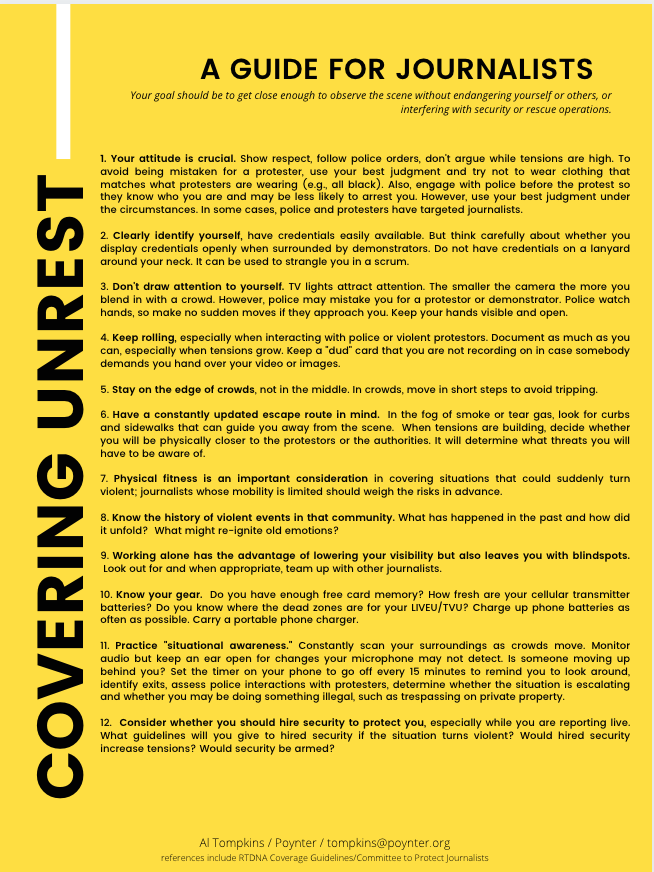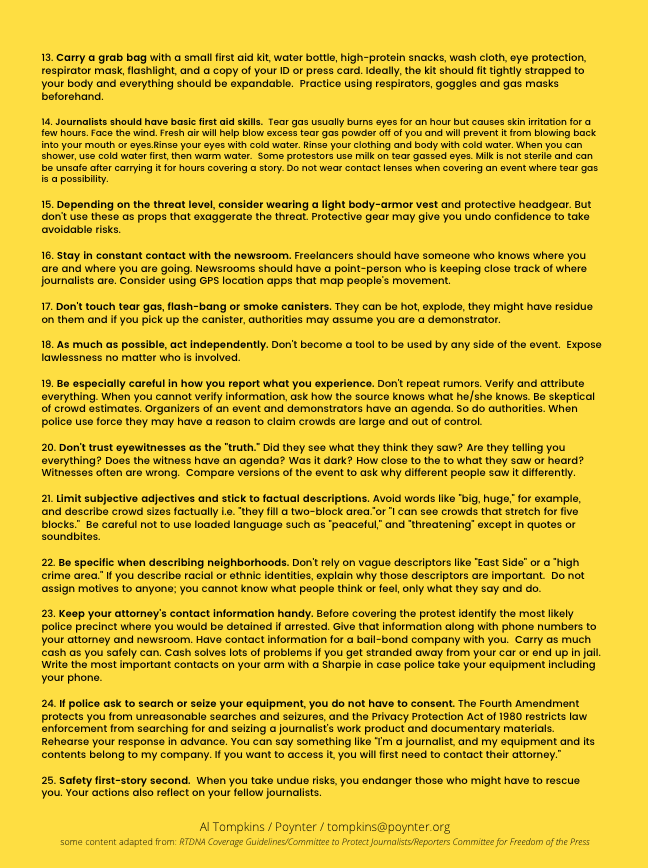A mob that laid siege to the U.S. Capitol on Jan. 6 quickly identified the journalists assigned to cover the attack as targets. Reporters on the scene were threatened, harassed and physically assaulted. Later that evening, police briefly arrested two journalists while their cameras rolled.
With the FBI warning of further armed protests across the United States in the next week, journalists will likely continue to find themselves in harm’s way as they document this turbulent story. Poynter has prepared a handout of safety guidelines (updated from a previous list for covering 2020’s protests) for you to use and circulate to staff.
Some of these guidelines have been adapted from the Radio Television Digital News Association Coverage Guidelines, the Committee to Protect Journalists and Reporters Committee for Freedom of the Press.
- Your attitude is crucial. Show respect, follow police orders, don’t argue while tensions are high. To avoid being mistaken for a demonstrator, use your best judgment and try not to wear clothing that matches what demonstrators are wearing (e.g., all black). Also, engage with police before the event so they know who you are and may be less likely to arrest you. However, use your best judgment under the circumstances. In some cases, police and protesters have targeted journalists.
- Clearly identify yourself and have credentials easily available. But think carefully about whether you display credentials openly when surrounded by demonstrators. Do not have credentials on a lanyard around your neck. It can be used to strangle you in a scrum.
- Don’t draw attention to yourself. TV lights attract attention. The smaller the camera, the more you blend in with a crowd. However, police may mistake you for a protester or demonstrator. Police watch hands, so make no sudden moves if they approach you. Keep your hands visible and open.
- Keep cameras rolling, especially when interacting with police or violent protesters. Document as much as you can, especially when tensions grow. Keep a “dud” memory card that you are not recording on in case somebody demands you hand over your video or images.
- Stay on the edge of crowds, not in the middle. In crowds, move in short steps to avoid tripping.
- Have a constantly updated escape route in mind. In the fog of smoke or tear gas, look for curbs and sidewalks that can guide you away from the scene. When tensions are building, decide whether you will be physically closer to the protesters or the authorities. It will determine what threats you will have to be aware of.
- Physical fitness is an important consideration in covering situations that could suddenly turn violent; journalists whose mobility is limited should weigh the risks in advance.
- Know the history of violent events in that community. What has happened in the past and how did it unfold? What might reignite old emotions?
- Working alone has the advantage of lowering your visibility but also leaves you with blind spots. Look out for and, when appropriate, team up with other journalists.
- Know your gear. Do you have enough free card memory? How fresh are your cellular transmitter batteries? Do you know where the dead zones are for your LIVEU/TVU? Charge up phone batteries as often as possible. Carry a portable phone charger.
- Practice “situational awareness.” Constantly scan your surroundings as crowds move. Monitor audio but keep an ear open for changes your microphone may not detect. Is someone moving up behind you? Set the timer on your phone to go off every 15 minutes to remind you to look around, identify exits, assess police interactions with demonstrators, determine whether the situation is escalating and whether you may be doing something illegal, such as trespassing on private property.
- Consider whether you should hire security to protect you, especially while you are reporting live. What guidelines will you give to hired security if the situation turns violent? Would hired security increase tensions? Would security be armed?
- Carry a grab bag with a small first aid kit, water bottle, high-protein snacks, washcloth, eye protection, respirator mask, flashlight, and a copy of your ID or press card. Ideally, the kit should fit tightly strapped to your body and everything should be expandable. Practice using respirators, goggles and gas masks beforehand.
- Have basic first aid skills. Tear gas usually burns eyes for an hour but causes skin irritation for a few hours. Face the wind. Fresh air will help blow excess tear gas powder off of you and will prevent it from blowing back into your mouth or eyes. Rinse your eyes with cold water. Rinse your clothing and body with cold water. When you can shower, use cold water first before warm water. Some protesters use milk on tear-gassed eyes. Milk is not sterile and can be unsafe after carrying it for hours covering a story. Do not wear contact lenses when covering an event where tear gas is a possibility.
- Depending on the threat level, consider wearing a light body armor vest and protective headgear. But don’t use these as props that exaggerate the threat. Protective gear may give you undue confidence to take avoidable risks.
- Stay in constant contact with the newsroom. Freelancers should have someone who knows where you are and where you are going. Newsrooms should have a point person who is keeping close track of where journalists are. Consider using GPS location apps that map movement.
- Don’t touch tear gas, flash-bang or smoke canisters. They can be hot, could explode, might have residue on them and, if you pick up a canister, authorities may assume you are a demonstrator.
- As much as possible, act independently. Don’t become a tool to be used by any side of the event. Expose lawlessness no matter who is involved.
- Be especially careful in how you report what you experience. Don’t repeat rumors. Verify and attribute everything. When you cannot verify information, ask how sources knows what they know. Be skeptical of crowd estimates. Event organizers and demonstrators have an agenda. So do authorities. When police use force, they may have a reason to claim crowds are large and out of control.
- Don’t trust eyewitnesses as the “truth.” Did they see what they think they saw? Are they telling you everything? Does the witness have an agenda? Was it dark? How close were they to what they saw or heard? Witnesses often are wrong. Compare versions of the event to ask why different people saw it differently.
- Limit subjective adjectives and stick to factual descriptions. Avoid words like “big” and “huge,” for example, and describe crowd sizes factually (e.g. “they fill a two-block area” or “I can see crowds that stretch for five blocks”). Be careful not to use loaded language such as “peaceful” or “threatening” except in quotes or soundbites.
- Be specific when describing neighborhoods. Don’t rely on vague descriptors like “east side” or “high crime area.” If you describe racial or ethnic identities, explain why those descriptors are important. Do not assign motives to anyone; you cannot know what people think or feel, only what they say and do.
- Keep your attorney’s contact information handy. Before covering the protest, identify the most likely police precinct where you would be detained if arrested. Give that information along with phone numbers to your attorney and newsroom. Have contact information for a bail-bond company with you. Carry as much cash as you safely can. Cash solves lots of problems if you get stranded away from your car or end up in jail. Write the most important contacts on your arm with a Sharpie in case police take your equipment, including your phone.
- If police ask to search or seize your equipment, you do not have to consent. The Fourth Amendment protects you from unreasonable searches and seizures, and the Privacy Protection Act of 1980 restricts law enforcement from searching for and seizing a journalist’s work product and documentary materials. Rehearse your response in advance. You can say something like “I’m a journalist, and my equipment and its contents belong to my company. If you want to access it, you will first need to contact their attorney.”
- Safety first, story second. When you take undue risks, you endanger those who might have to rescue you. Your actions also reflect on your fellow journalists.
Please download and share these guidelines with colleagues.









